Last Updated on April 17, 2025 by Laura Turner
In 2023, AAMC revised the AAMC Premed Competencies to align with the PREview situational judgment test, incorporate changes in medical education after the COVID-19 pandemic, and emphasize the importance of embracing community diversity and inclusion concepts to train future physicians (AAMC, “Refreshing the Premed Competencies”).
Previously, I discussed the importance of Academic Competencies. With this article, I also wanted to show how your activities (outside the premed AMCAS or AACOMAS applications) are viewed to identify characteristics that reveal your readiness for a health professional career.
AAMC Anatomy of an Applicant
Many prehealth advisors encourage aspiring applicants (including pre-dental and pre-veterinary students) to complete the AAMC “Anatomy of an Applicant” guide, which addresses the Premed Competencies. Students consider how specific activities helped them gain confidence in their competency development and find their voice if an activity is personally meaningful. Additional testimonials help applicants see how medical students describe their activities and accomplishments with an eye toward the Premedical Competencies evaluators seek.
The Pre-Professional Competencies
Over the last decade, health professions students have gained clinical and community health exposure earlier in the curriculum as the programs favor real-world applications of lecture-taught content. Students are expected to be prepared to engage with diverse communities and peers earlier, and many applicants bring lots of valuable lived experiences. The competencies were redefined to reflect these changes (Table 1).
Pre-Professional Competencies and Behaviors occur within and beyond academic settings, so screeners seek evidence of consistent observation and growth within the nine AAMC domains. These “power skills” are desired in general society and are associated with success in other professions and employment. Consequently, one should be able to determine how these competencies are applied in clinical and real-world settings through situational judgment or behavioral tests, such as the Casper exam.
As the rubric (Table 2, below) shows, many actions may intersect multiple competencies, depending on the context of an observation. Fostering a hospitable environment that affirms the diversity of a learning community requires all of the Pre-Professional Competencies; the rubric rewards those who actively played a role in building, sustaining, or improving one’s campus community, workplace, or volunteer group to live up to their core values.
Table 1. Pre-Professional Competencies 2023
Items are bolded to highlight specific or more explicit changes.
- Commitment to Learning and Growth (previously Capacity for Improvement): Practices continuous personal and professional growth for improvement, including setting and communicating goals for learning and development; reflects on successes, challenges, and mistakes; pursues opportunities to improve knowledge and understanding; and asks for and incorporates feedback to learn and grow.
- Cultural Awareness (previously part of Cultural Competence): Appreciates how historical, sociocultural, political, and economic factors affect others’ interactions, behaviors, and well-being; values diversity; and demonstrates a desire to learn about different cultures, beliefs, and values.
- Cultural Humility (previously part of Cultural Competence): Seeks out and engages diverse and divergent perspectives with a desire to understand and willingness to adjust one’s mindset; understands a situation or idea from alternative viewpoints; reflects on one’s values, beliefs, and identities and how they may affect others; reflects on and addresses bias in oneself and others; and fosters a supportive environment that values inclusivity.
- Empathy and Compassion (previously part of Service Orientation): Recognizes, understands, and acknowledges others’ experiences, feelings, perspectives, and reactions to situations; is sensitive to others’ needs and feelings; and demonstrates a desire to help others and alleviate others’ distress.
- Ethical Responsibility to Self and Others: Behaves with honesty and integrity; considers multiple and/or conflicting principles and values to inform decisions; adheres to ethical principles when carrying out professional obligations; resists
peerpressure to engage in unethical behavior; and encourages others to behave honestly and ethically.Develops and demonstrates ethical and moral reasoning - Interpersonal skills (previously Social Skills): Demonstrates an awareness of how social and behavioral cues affect people’s interactions and behaviors; adjusts behaviors appropriately in response to these cues; recognizes and manages one’s emotions and understands how emotions impact others or a situation; and treats others with dignity, courtesy, and respect.
- Oral Communication: Effectively conveys information to others using spoken words and sentences; actively listens to understand the meaning and intent behind what others say; and recognizes potential communication barriers and adjusts approach or clarifies information as needed.
- Reliability and Dependability: Demonstrates accountability for performance and responsibilities to self and others; prioritizes and fulfills obligations in a timely and satisfactory manner; and understands consequences of not fulfilling one’s responsibilities to self and others.
- Resilience and Adaptability: Perseveres in challenging, stressful, or ambiguous environments or situations by adjusting behavior or approach in response to new information, changing conditions, or unexpected obstacles, and recognizes and seeks help and support when needed; recovers from and reflects on setbacks; and balances personal well-being with responsibilities.
- Service Orientation: Shows a commitment to something larger than oneself; demonstrates dedication to service and a commitment to making meaningful contributions that meet the needs of communities.
- Teamwork and Collaboration (previously Teamwork): Collaborates with others to achieve shared goals and prioritizes shared goals; adjusts role between team member and leader based on one’s own and others’ expertise and experience; shares information with team members and encourages this behavior in others; and gives and accepts feedback to improve team performance.
Citations: https://students-residents.aamc.org/media/15376/download , https://students-residents.aamc.org/media/15396/download , and https://students-residents.aamc.org/media/15361/download (Accessed February 2, 2024),
A Self-Assessment for Pre-Professional Competency
Applicants can be scored using this rubric for Pre-Professional Competencies. Unlike the Academic Competencies Rubric, this hypothetical grid acts more like a “bingo card” where all subcompetencies must be addressed. The sub-competencies each point to a specific observable result, and a score is assigned based on the consistency of this competency among all academic and extracurricular activities mentioned in the application, including in secondary essays. The ideal applicant would have addressed all the sub-competencies beyond expectations; usually, the size of the application and limits to interviewing prevent applicants from filling all the rubric spots with “beyond expectations” scores.
Let’s consider how this rubric can evaluate competencies based on meaningful activities:
Jessie has worked for a year as an intake secretary in a non-profit “one-stop” clinic that serves a medically underserved neighborhood with many non-English-speaking immigrants. Jessie often connects individual patients to social workers (to get reduced-cost bus passes) and law students running a pro bono service (securing housing assistance). Jessie has helped over 100 people and has many examples to consider this activity personally and professionally meaningful.
How would you help Jessie describe this experience in the Work/Activities section and secondary essays asking about her interests in helping underprivileged communities?
Jan has a leadership role as a team captain and coordinator for an intramural soccer club. Jan’s selection as captain came after only one year of membership, but conflicts make it challenging for the team to have enough players for each Tuesday night practice or scheduled game. The team does not always make it to their playoffs, but Jan enjoys the company of their teammates during practices and games.
Help Jan describe their role with the soccer team. What competencies should be mentioned?
When describing this experience for the Work/Activities Inventory, the applicant cannot hit all the spots on the rubric due to character limits but may be able to complete the picture with follow-up essays, interviews, or a letter of recommendation from the clinic supervisor.
Similar rubrics evaluate clinical, non-clinical/community, or academic/co-curricular experiences. A program may assign one screener to assess the clinical experiences and another to community service.
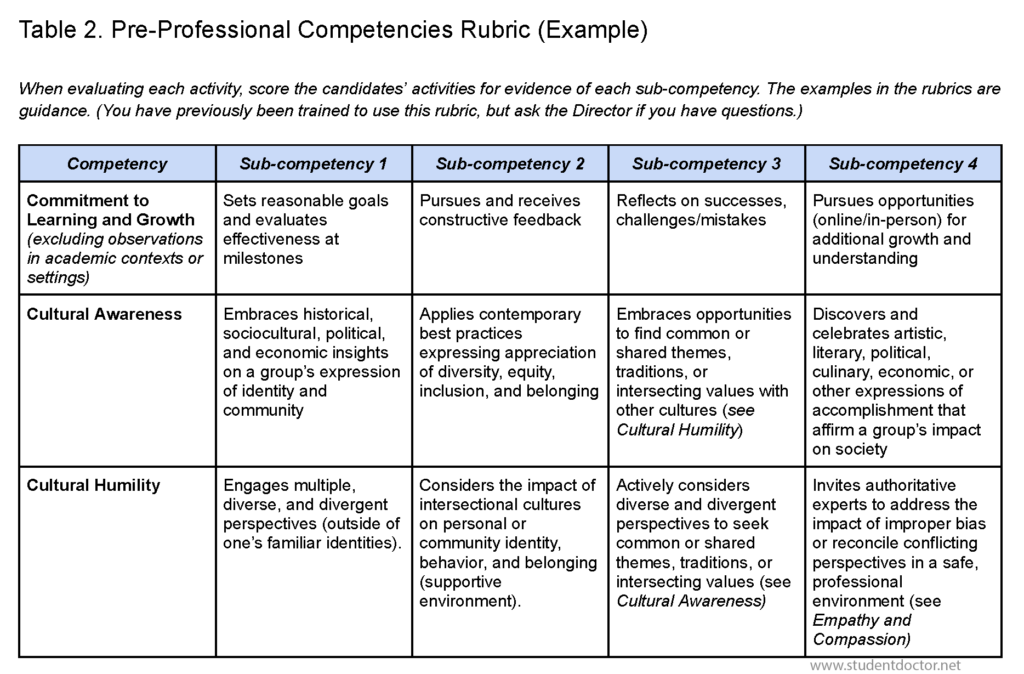
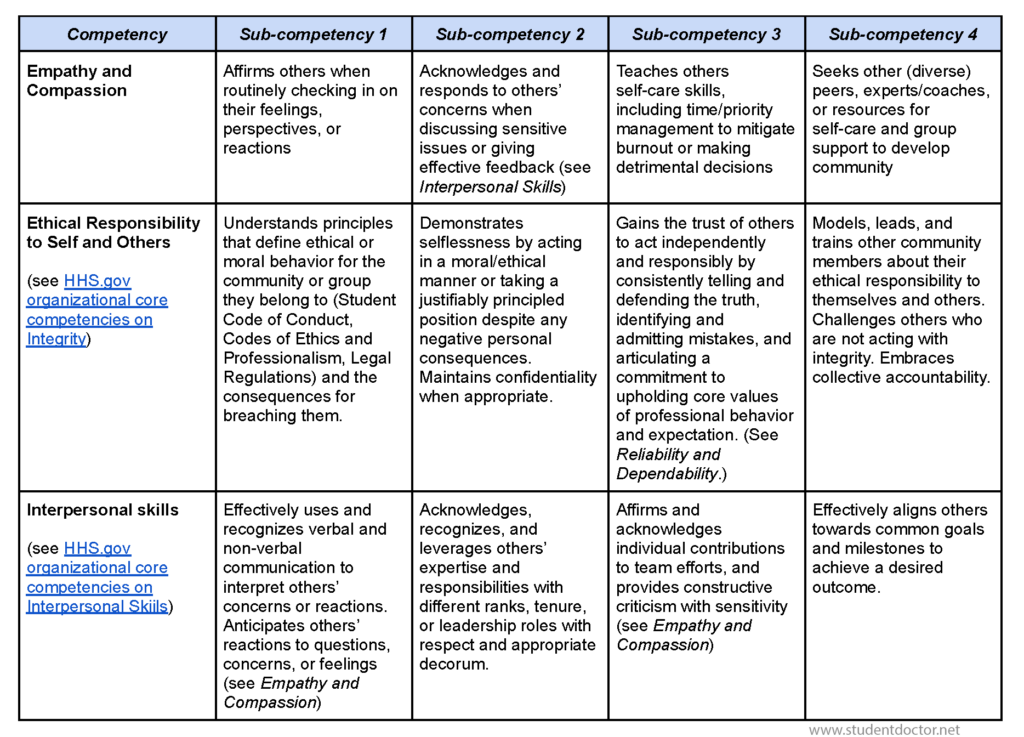
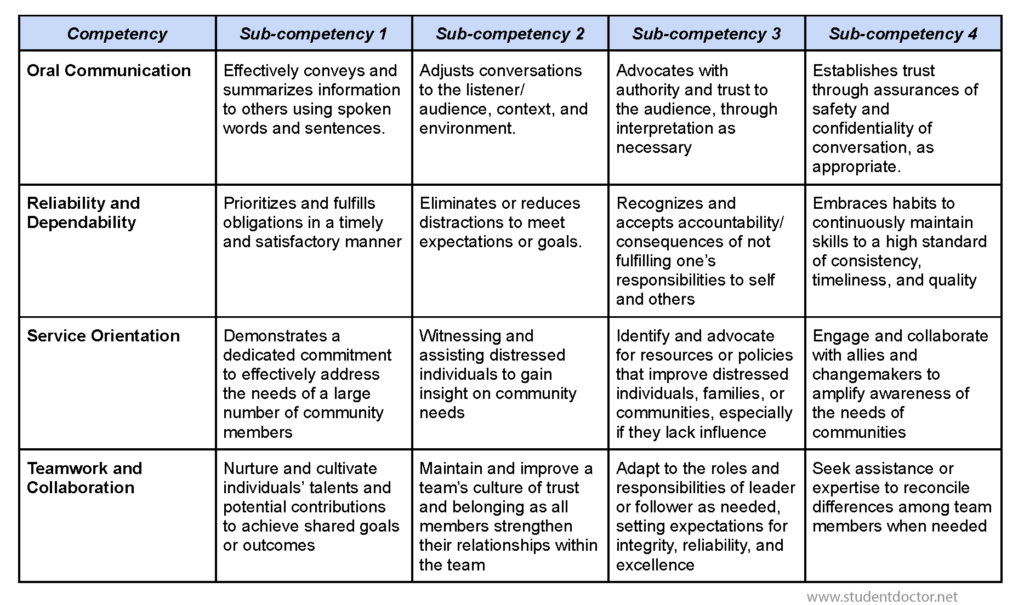
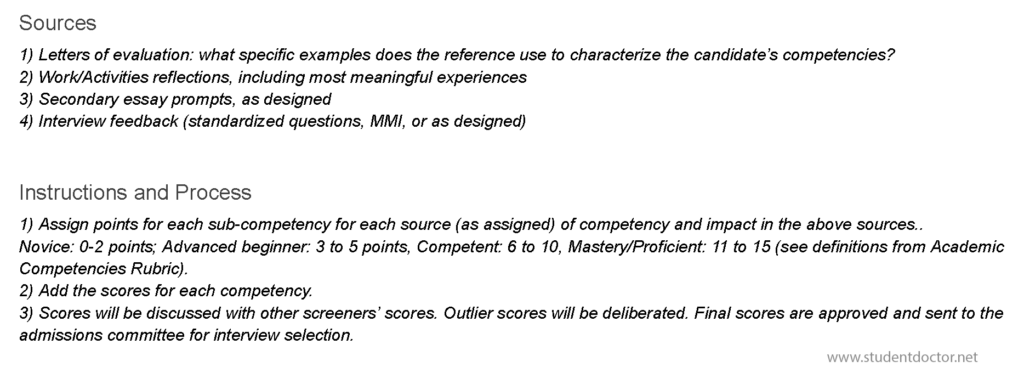
Identifying Key Competencies in PREview-like Scenarios
The Pre-Professional Competencies are mainly tested with the AAMC PREview exam. As you prepare for PREview, try to identify the combination of competencies each scenario evaluates. Then rate the responses as effective or ineffective based on these competencies. The following scenario is stylistically similar to those in the PREview practice exams:
You and your classmate Lin volunteer to work the front desk at a clinic, greeting new visitors and answering questions. While you arrive on time for your shift, Lin arrives 20 minutes late and seems distracted. As the shift progresses, Lin constantly checks messages on their cell phone. The volunteer coordinator arrives at your desk for a check-in; after Lin puts away the phone, Lin tells the coordinator how happy they are to work at the desk today.
In this scenario, you can anticipate interpersonal challenges between you and Lin, upholding ethical behavior regarding reliability/dependability and empathy/compassion for your partner’s distractions. Confronting your partner in private will also involve skillful oral communication skills and an opportunity to gain cultural awareness. Anticipate responses that can affect the relationships with your friend and the volunteer coordinator.
When preparing for PREview, consider how the competencies are mapped in each scenario and follow-up response. Discuss your thoughts on the explanations in the exam answer key with a small group of trusted peers. Your goal is to align your answers consistently with the consensus explanation from the academic educators, not agree with any approach you may take. Pay attention to demographic details (like race/ethnicity proxies such as clothing or hairstyles) of the other characters in each scenario, as they may affect the effectiveness of your response.
The standardized PREview scenarios do not accommodate nuances; the classmate could be distracted by upsetting news from family or a friend, or they could be doom-scrolling through social media. You should recognize initial assumptions but not quickly act upon them when assessing a response’s effectiveness. More importantly, one should refrain from being distracted by the lack of details that could change the effectiveness of a given response.
You should consider the conflicts of priorities. In this scenario, you have a collegial relationship with Lin. Is it appropriate for you to call Lin out in front of the supervisor, especially in a front-desk low-accountability volunteer role? This situation engages multiple competencies on the rubric, and you can anticipate how each proposed prompt/response will test you on specific competencies (reliability vs. service orientation vs. oral communication vs. teamwork…).
Assessing Pre-Professional Competencies in Letters of Evaluation
Strong evaluations come from supervisors or professors with specific examples demonstrating the candidate’s pre-professional competencies. In justifying their evaluations, referees typically cite candidates’ reliability and dependability (completing tasks or projects thoroughly), oral communication (through presentations), motivation/service orientation, and teamwork/collaboration (working in groups). To secure a letter of evaluation, a candidate should guide each reference and meet frequently as the reference drafts the evaluation. This rubric can help candidates recall situations and accomplishments for references to describe their competencies and growth toward a professional career.
Additional Pre-Professional Competencies
Applicants are also evaluated on program-specific competencies. Many schools have specific tracks toward rural health or social justice advocacy. Additional skills and competencies may also be expected from applicants to non-MD programs. Table 3 shows examples of how such desired qualities could be addressed. As applicants, you should be able to fill in your own activities and reflections to complete a similar table for your desired program.
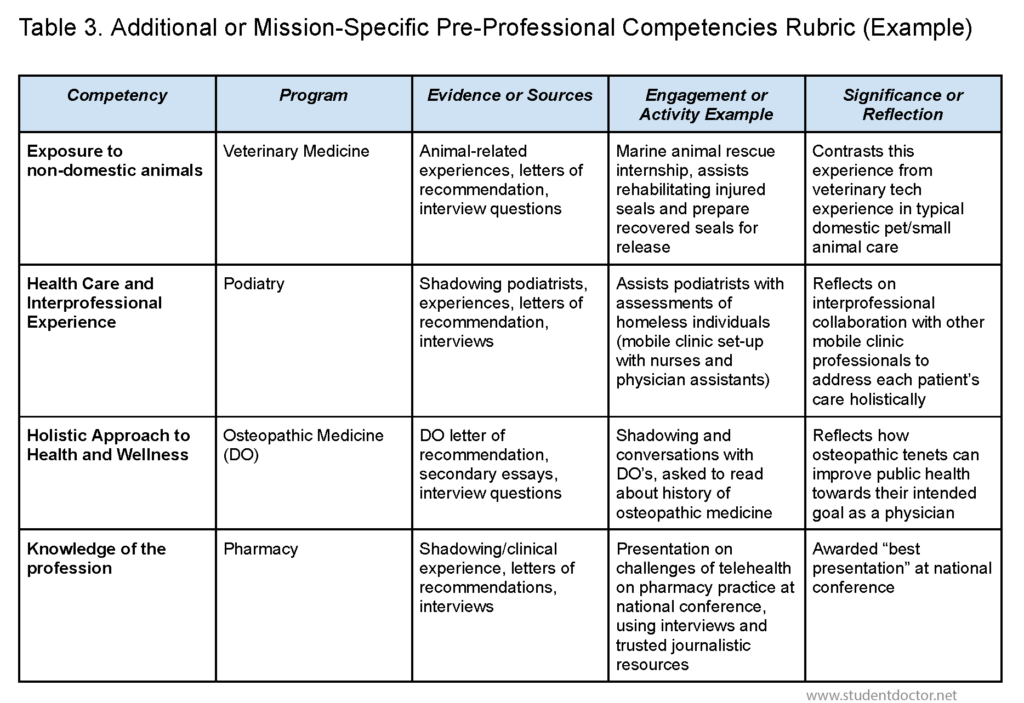
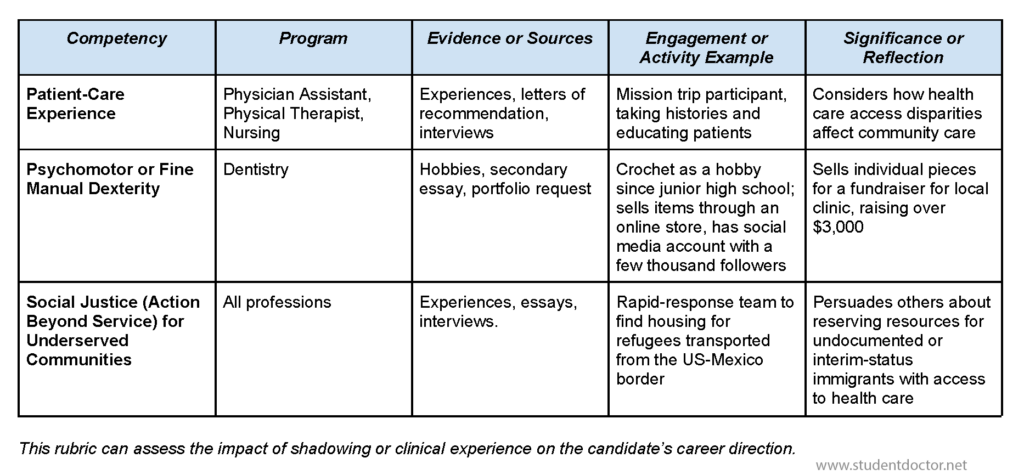
Get the Rubrics PDF
Please enter your email below to get a printable PDF version of the pre-professional and academic competencies rubrics sent to your email.
Endnotes
This article is an updated version of the following book chapter:
Chuck ET and Elam C (2022). Using Pre-Professional Competencies in Advising, Tracking, and Writing Letters of Evaluation. Handbook of Research on Developing Competencies for Pre-Health Professional Students, Advisors, and Programs. Ganjoo R and Schwartz LS, editors. DOI: 10.4018/978-1-6684-5969-0.ch010 Accessible at https://www.irma-international.org/viewtitle/305097/?isxn=9781668459690 .
This article is developed for the Becoming a Student Doctor resource developed by HPSA. Join as a Gold Member or request a scholarship for personalized advice to build a compelling mission-focused application profile.
